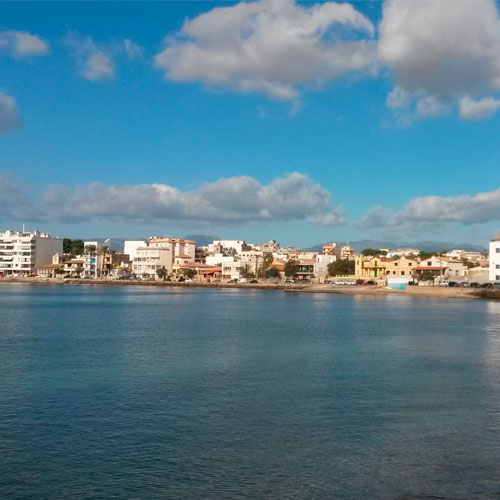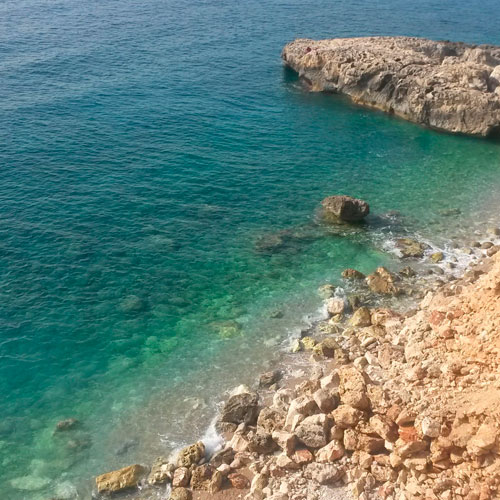Palma-Colònia de Sant Jordi - Tourism
Palma-Colònia de Sant Jordi
We drive along the highway in direction airport until reaching the exit that leads us to Llucmajor. On the way we will see, to our left, numerous windmills. Far away, we will be able to see the village of Sant Jordi.
Once on the road to Llucmajor we will the landscape changes completely: brushwood and shrubs (garriga). A few kilometres further on we will enter the village of Llucmajor, www.llucmajor.org
In the year 1349, in the prairie of Galdent, Pedro IV of Aragón and Jaime III of Mallorca fought the famous battle of Llucmajor. During this battle, the latter lost, apart from his kingdom, his life.
In Llucmajor we will have the opportunity to visit the church of Sant Miquel, a neoclassical building that dates back to the XIXth century, a work by the architect Isidoro González Velázquez. We will also find the Franciscan Convent, dedicated to Saint Buenaventura and built at the end of the XVIIth century. It has a nave and six lateral chapels. The altar is held in the Barock style.
In the outskirts of this village, on our way to Campos, we will find remainings of the huge Llucmajor group of windmills. The main windmill is the Gaspar windmill that has been carefully refurbished. If we take a small detour and we drive along the road to Algaida, approximately 4.5 Km away, we will find the road leading to the Cura sanctuary and the monastery of Randa. It can be reached by car and from up above, the view is impressive. Nowadays, Cura is the venue of the Lullian museum. Nearby the sanctuary we will find the cave where, Ramon Llull developed his philosophic system (in the year 1275).
We go back to the main road to continue our trip to Campos https://www.a-campos.es. Upon entering the village we will be able to see the Sant Julià church, that was built between 1855 and 1873 in a neo-classical style. Its dimensions are huge. The bell-tower dates back to the XVIth century.
The parish church museum is located within the church and, amongst others, displays a painting from Murillo.
The village of Campos is characterised by numerous other buildings, such as towers built on a square base for defense purposes to protect the population from enemies. In ancient times, Campos had a total of seven towers within the city. Nowadays, some have been turned into housing while some have maintained their defense properties.
At the end of the visit we head towards Felanitx. www.ajfelanitx.net . In Felanitx we will be able to visit the Sant Miquel church, that was built between 1551 and 1603, as well as the Sant Agustí convent, that was created in the year 1603.
It is worth going up to the Sant Salvador sanctuary that is located approximately 611 metres above sea level.
Should you have enough time, you may visit the ruins of the Santueri castle, that is not located far away from the village.
Now we will head towards Santanyí https://www.ajsantanyi.net/.
The municipality of Santanyí has a total surface of 126.3 Km. and a population of 7,907 inhabitants. Once in the village of Santanyí you will be able to visit the Porta Murada, that is part of the wall built in the XVIth century, that can still be visited. The two churches, the Roser church and the Sant Andreu parish church, are worth a visit too. The Sant Andreu parish church has a Sant Domingo organ that became part of the church in the year 1837. Every year, music lovers gather together for the different concerts celebrated by this church within this municipality. Leaving the village and heading towards Alqueria Blanca we will find the Consolació sanctuary.
The Mondragó natural park belongs to this municipality. The total surface of the natural park is of 785 hectares and its main formations are: coastal cliffs, coastal juniper trees, fauna typical for humid areas, Mediterranean shrub, pine-trees as well as traditional dry farming crops.
Should you visit this area in the spring or during the summer, take the chance to visit the numerous beaches located in the area. Starting from Cala Figuera, a beautiful fishing village with steep streets through to Cala Ferrera, Cala d'Or, Portopetro or Cala Santanyí until reaching the Mondragó park, all of them are worth a visit.
We end our visit by reaching the Colònia de Sant Jordi, an old fishing village. Nowadays it has become a huge touristic centre, mainly visited by the Majorcan local people. The beaches surrounding Colònia de Sant Jordi are spectacular, without any buildings that could disturb the harmony imposed by nature. From here we will be able to see the island of Cabrera, that nowadays has been turned into a national park.
Should you wish to visit the island of Cabrera, please visit the area on this website dedicated to the archipelago. In this section you will find all details you may require for a visit.
Now the time has arrived to drive back to Palma. Further on you will find the distance in kilometres that you will cover if you choose to do this excursion. If you wish, and if you have time for it, we highly recommend you to drive back to Palma through Cala Pi. This is where you will find a prehistoric village called Capocorb Vell. It is in a perfect state and is being considered as one of the most important megalithic monuments among the Mediterranean.
The tour can be made by car, by participating at an excursion organised by a travel agency or, if you choose to travel by public transport, by taking the bus. In case you choose to use the public transport, please visit the menu "Transport on the island" on this website. However, at this point we must highlight that the buses will not stop-by frequently.
Duration of the excursion: All day, including the breaks
Total distance covered: 140.2 km
from which:
Palma - Llucmajor 28.8 km
Llucmajor - Felanitx 27.9 km
Felanitx - Santanyí 15.8 km
Santanyí - Colònia de Sant Jordi 14 km
Colònia Sant Jordi - Palma 53.7 km
OPENING HOURS
- PREHISTORIC VILLAGE "CAPOCORB VELL"
Tel. 971 180 155
Opening hours
From 10:00 hours until 17:00 hours.
Closed on Thursdays
Date last modified: March 13, 2023



















